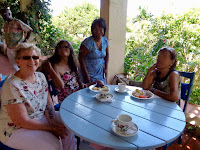We drove to Levera Beach, a spawning ground for the leatherback turtle, in the north east corner of the main island. On the way there, Carol had spotted what looked like a long runway on the map, just north of Grenville, and we determined to seek it out on the way back. The GPS got us down a dirt track to an intersection and there we spotted a bunch of guys sitting around a fire. As we slowed to determine our next move, one guy leapt up and ran towards us, his dreadlocks waving as he ran. Carol was uneasy but I wound down the window. “Are you looking for the old airfield?” he said, and he pointed the way – a human signpost had saved us again.
It turns out we’d found Pearls, Grenada’s original airport, built in the early 1940’s and in operation until the US invasion of the island. The runway still runs from the coast towards the mountains, almost as far as the eye can see; the coastal end barricaded by a huge bank of earth. A large area at the far end is set-up for drag racing with the start-line marked by characteristic, vertical lighting masts, one on each side.
 It was here on 25 October 1983, six days after Maurice Bishop’s assassination, that the US Marines landed when the US launched their invasion, codenamed Operation Urgent Fury. As they touched down here, the Army Rangers attacked Point Salines, now Maurice Bishop Airport. At the time, the invasion was heavily criticized by the international community, including Canada and the UK, but the Grenadians welcomed it, largely because of the limited casualties among the local population. And, it restored democracy with a new government, initially appointed by the Governor General Paul Scoon; quickly followed by elections.
It was here on 25 October 1983, six days after Maurice Bishop’s assassination, that the US Marines landed when the US launched their invasion, codenamed Operation Urgent Fury. As they touched down here, the Army Rangers attacked Point Salines, now Maurice Bishop Airport. At the time, the invasion was heavily criticized by the international community, including Canada and the UK, but the Grenadians welcomed it, largely because of the limited casualties among the local population. And, it restored democracy with a new government, initially appointed by the Governor General Paul Scoon; quickly followed by elections. 
Off to one side of the runway, there are two derelict Soviet-built Tupolev passenger aircraft, operated at the time by Cubana, evidence of Cuba’s involvement in the island. Now, they are sadly hollow; plundered, overgrown and surrounded by grazing goats. One had a woman’s purse (handbag) hanging off the landing gear… …the last passenger to lose their luggage here, or did it belong to the goat?
 The US had received requests for help from the Governor General and other Caribbean governments, although they had their own reasons to attack. Their main justification was the safety of 1,000 American citizens at St George’s University (SGU) campus (students and their families) but US intelligence suggested a Soviet-backed, Cuban-style, military build-up.
The US had received requests for help from the Governor General and other Caribbean governments, although they had their own reasons to attack. Their main justification was the safety of 1,000 American citizens at St George’s University (SGU) campus (students and their families) but US intelligence suggested a Soviet-backed, Cuban-style, military build-up. |
| SGU Campus |
The SGU students were evacuated and sent to other US universities until the Grenada government stabilized.
 It turns out that our friend in Grenada had connections at SGU and she was able to get us into the campus’ private pool one morning. It made for a relaxing soak in the sun!
It turns out that our friend in Grenada had connections at SGU and she was able to get us into the campus’ private pool one morning. It made for a relaxing soak in the sun!







































